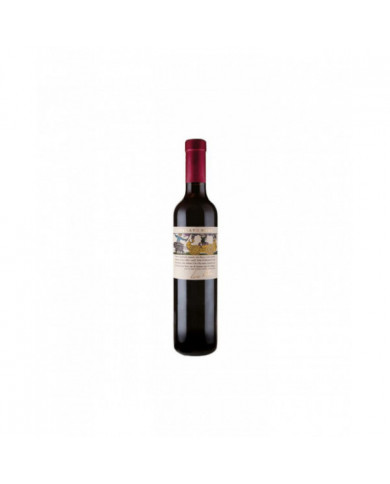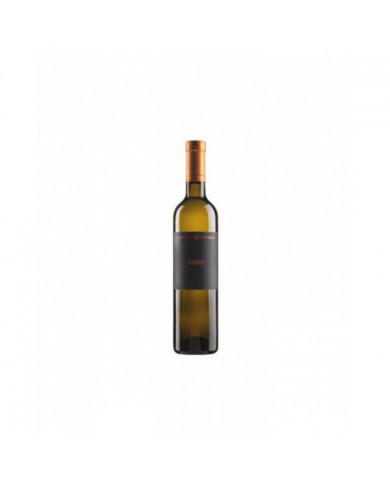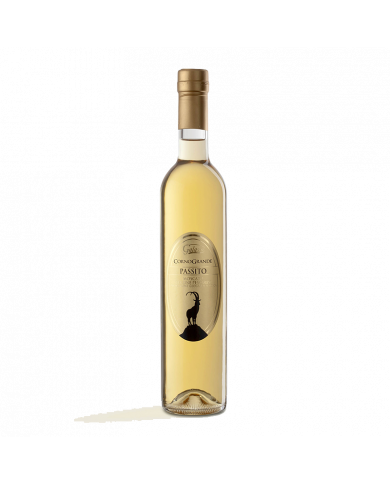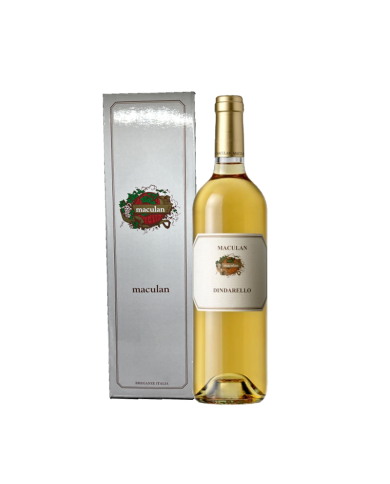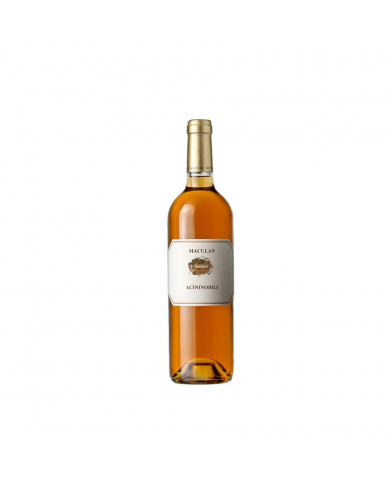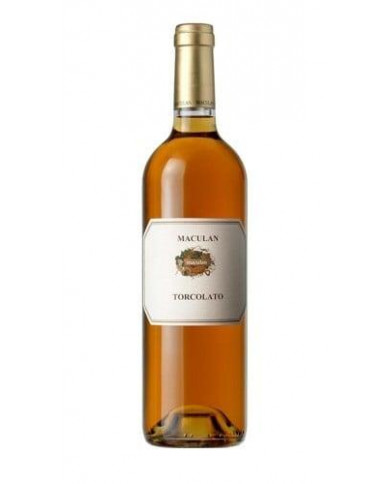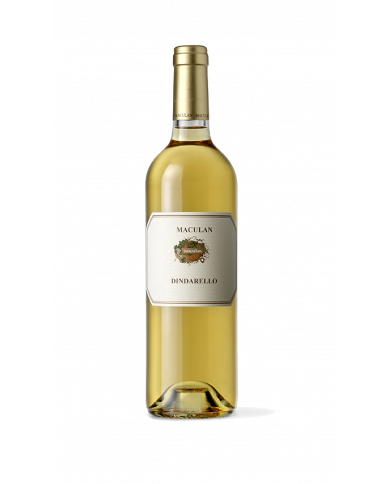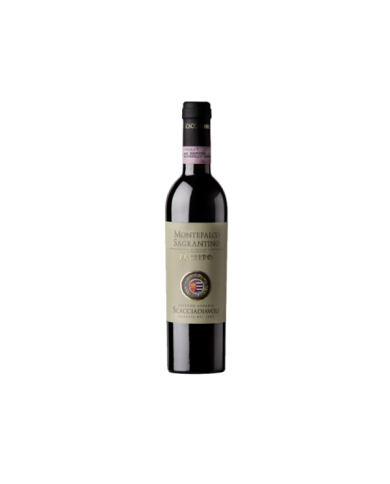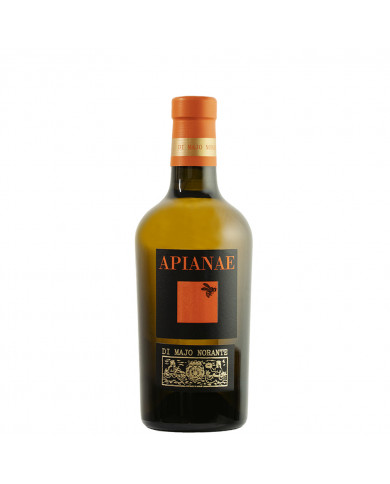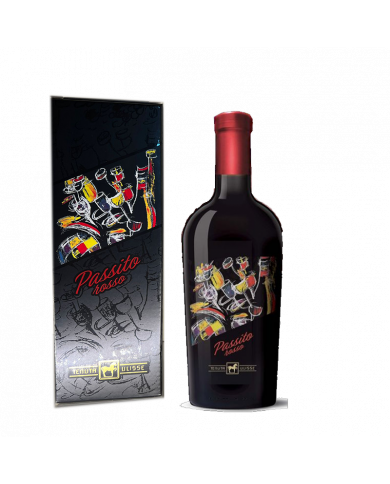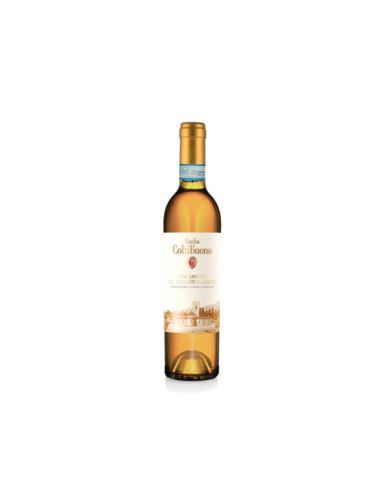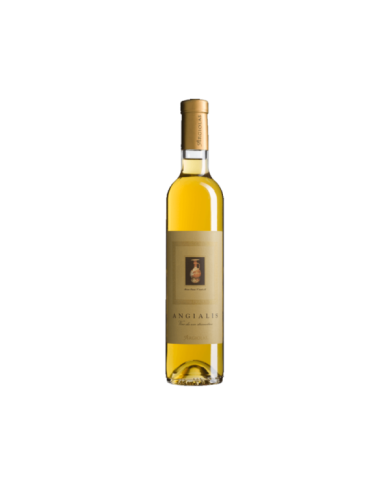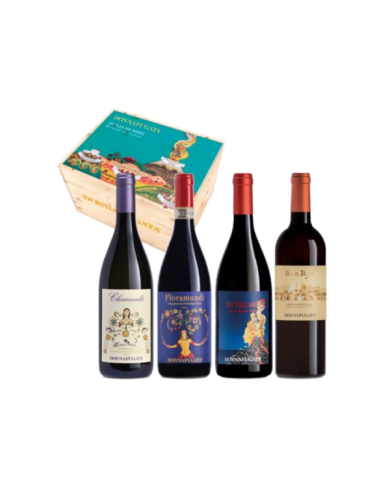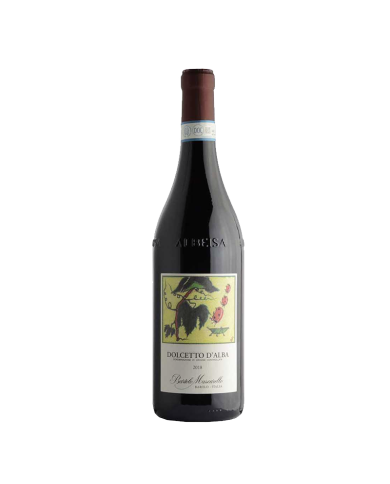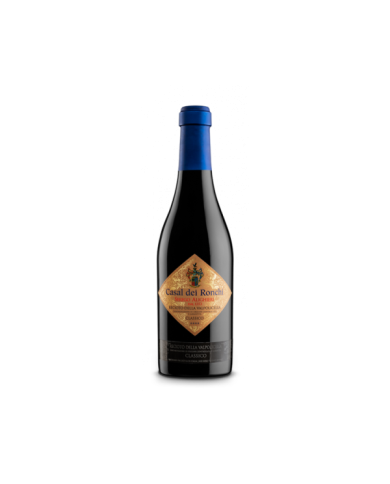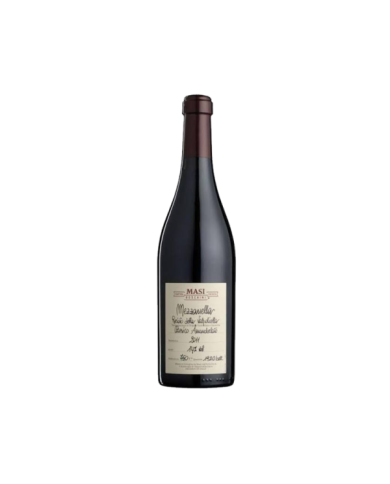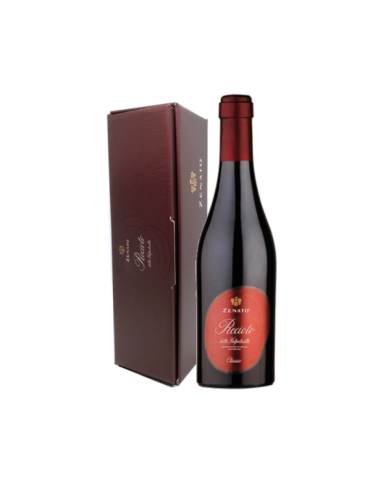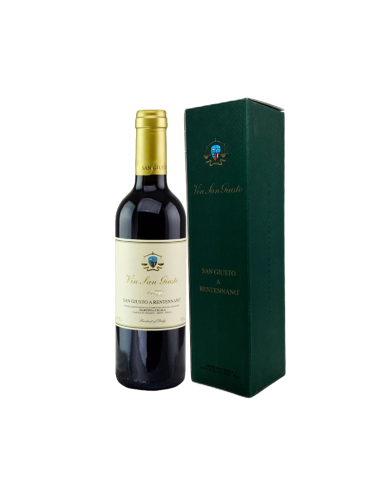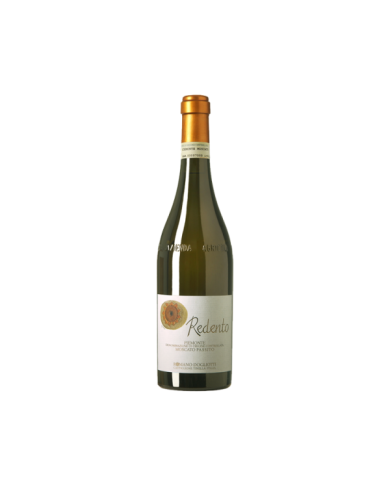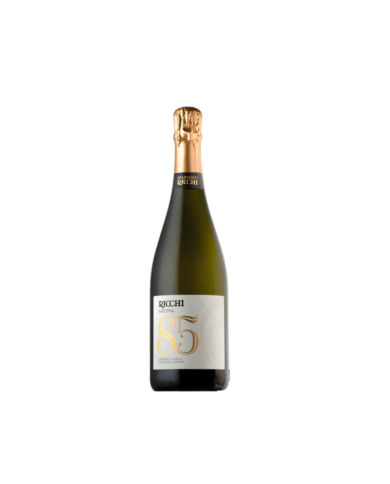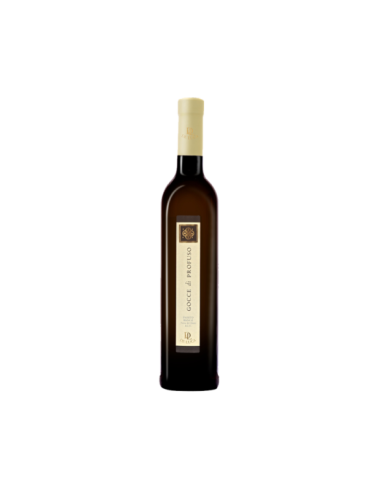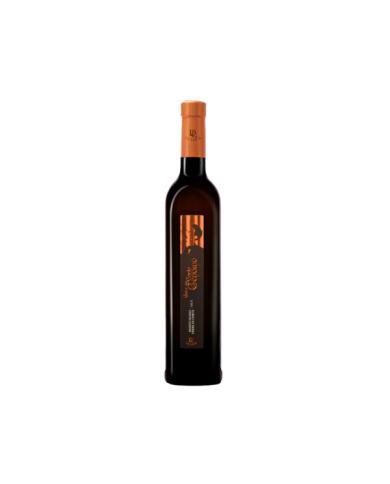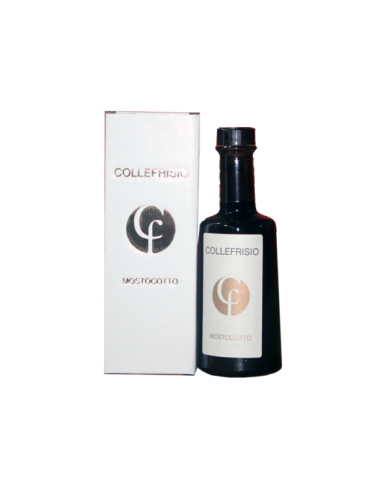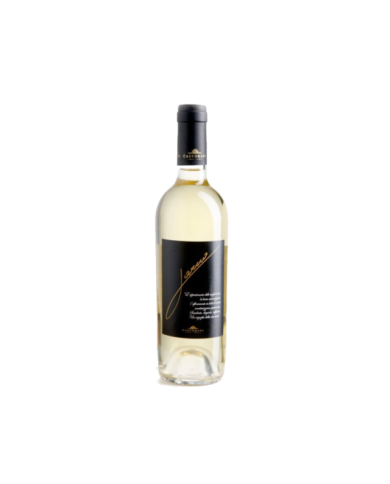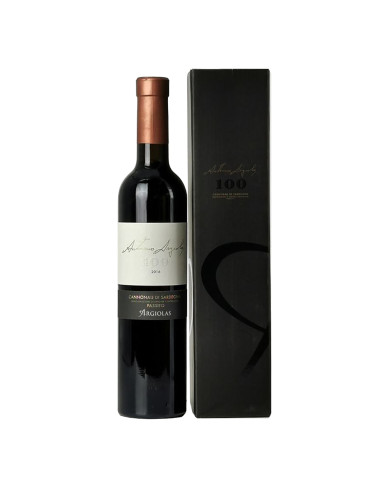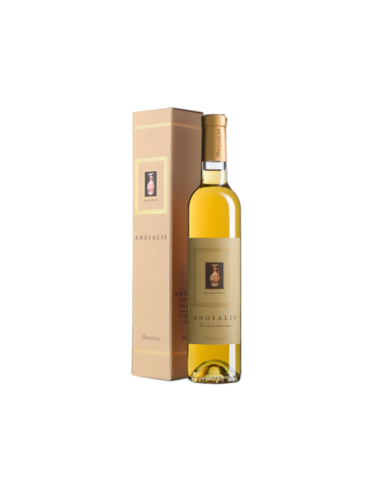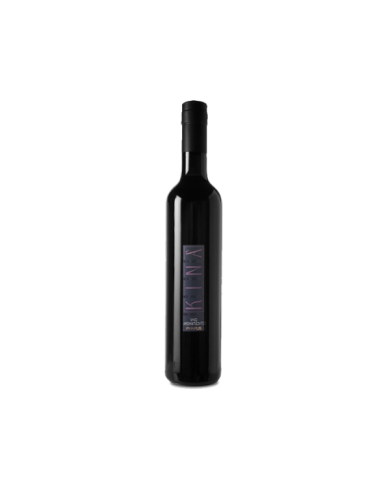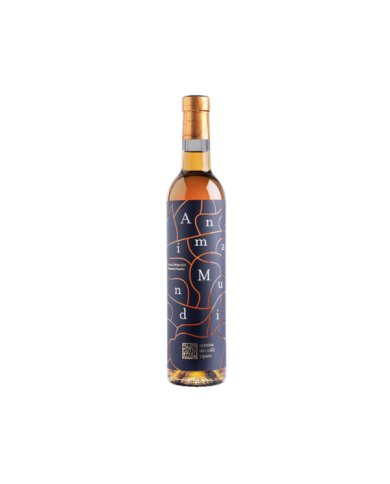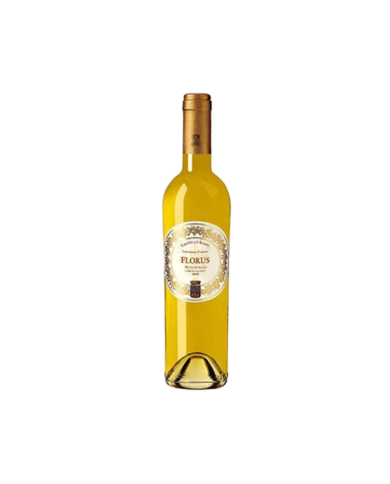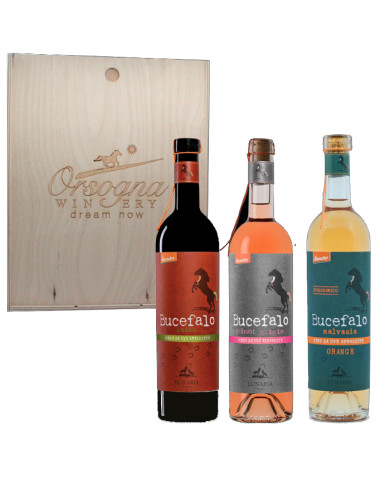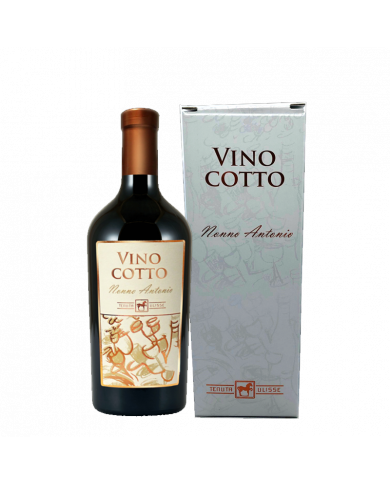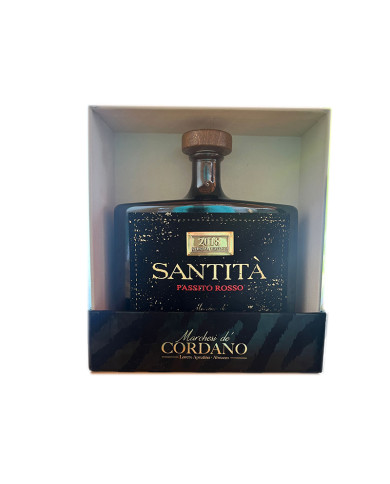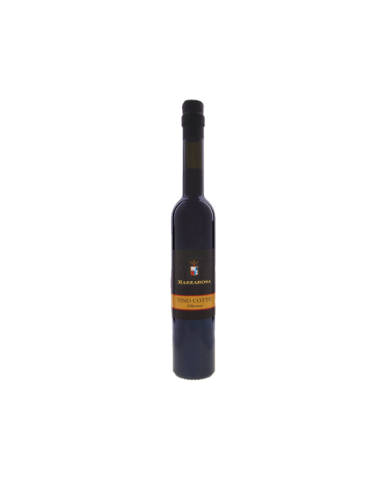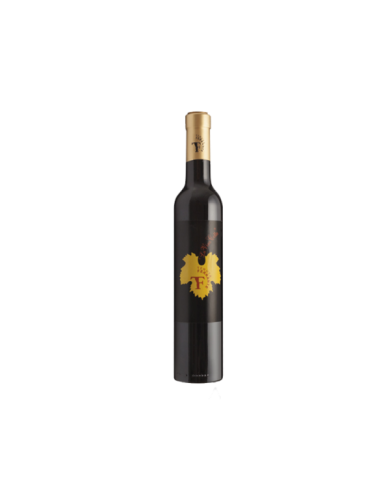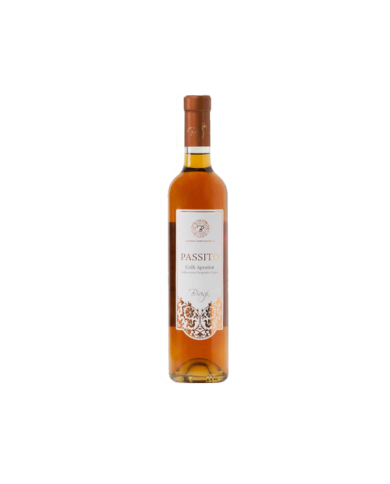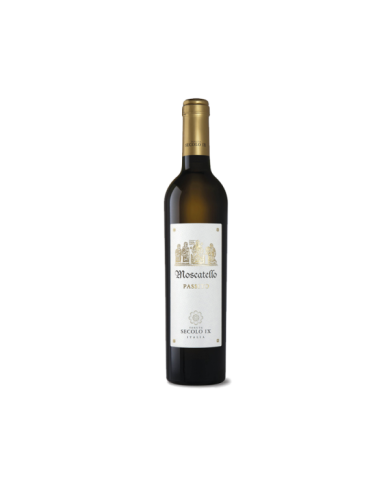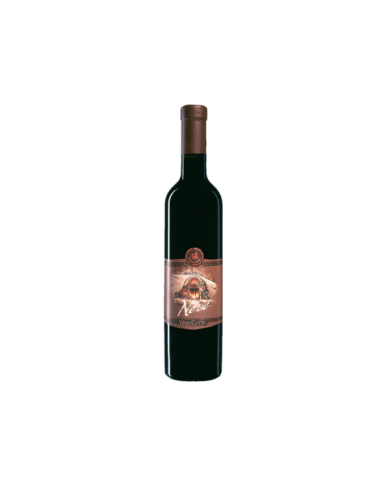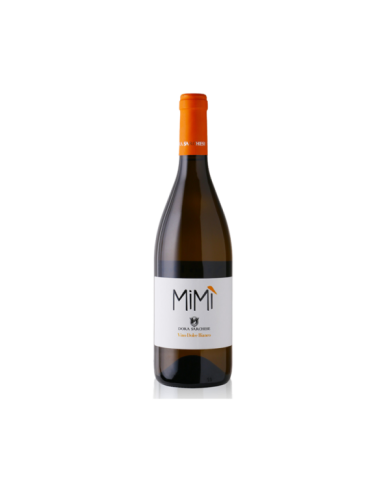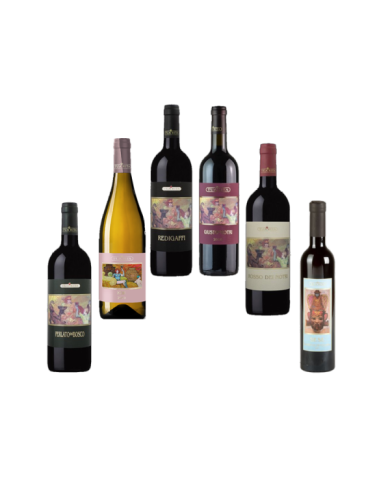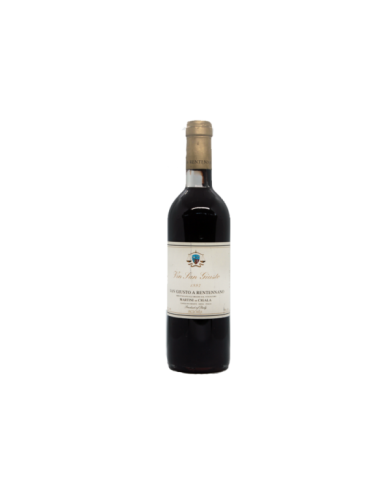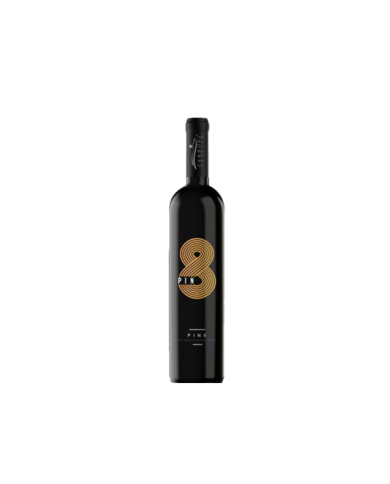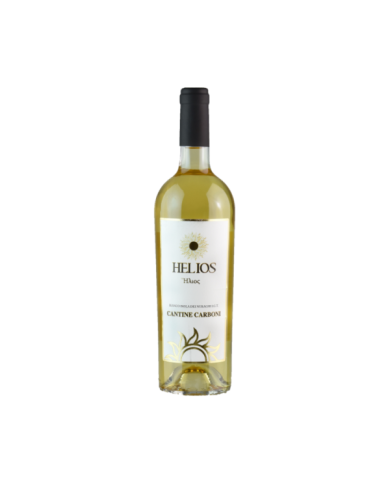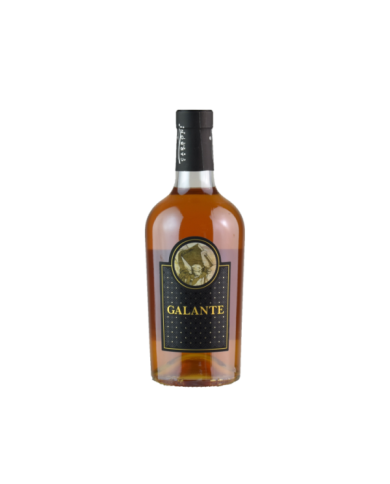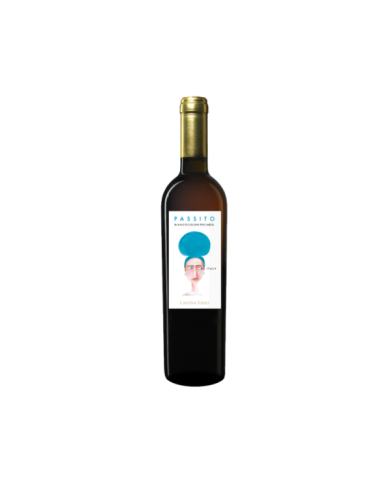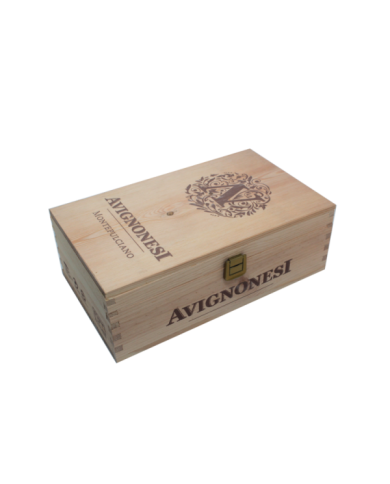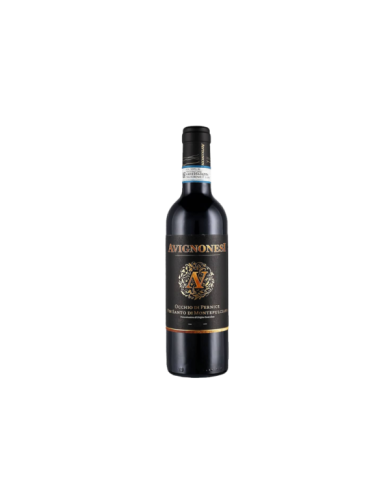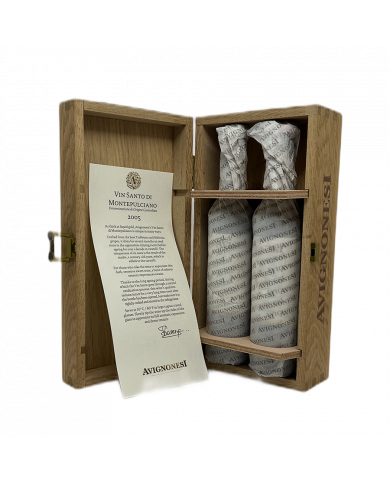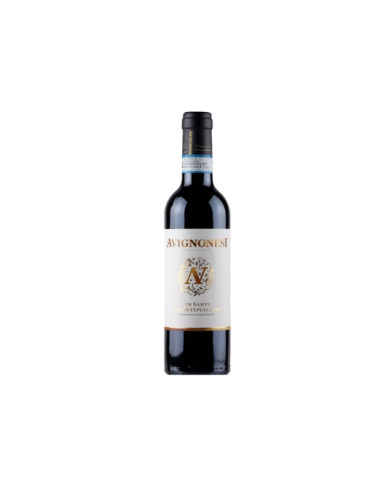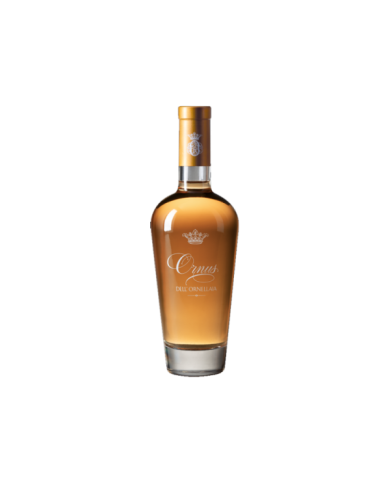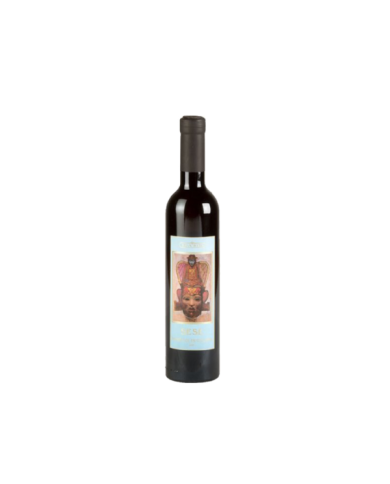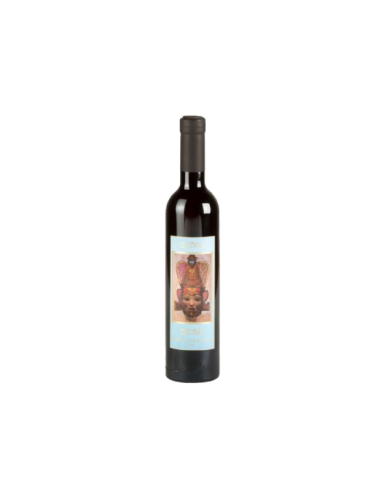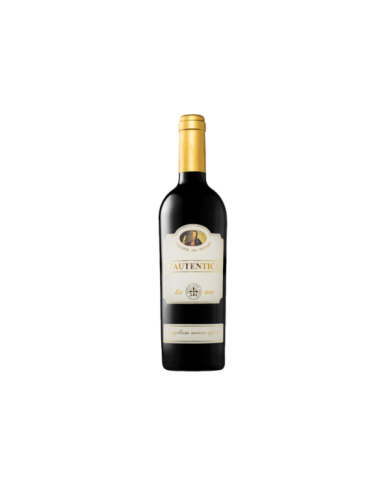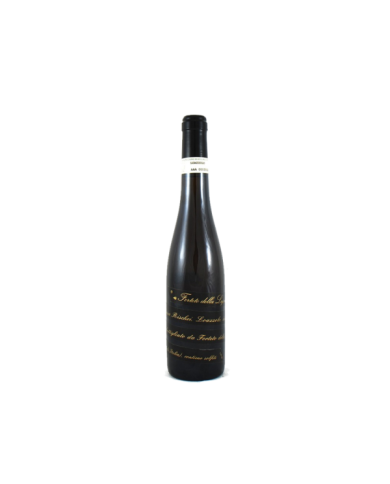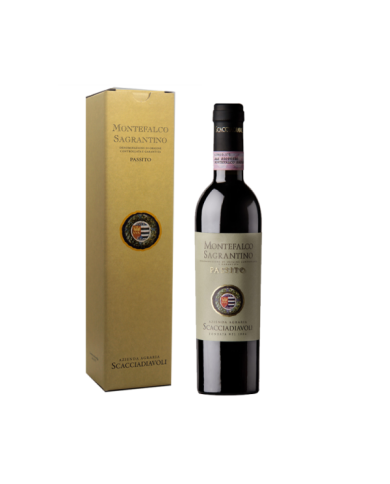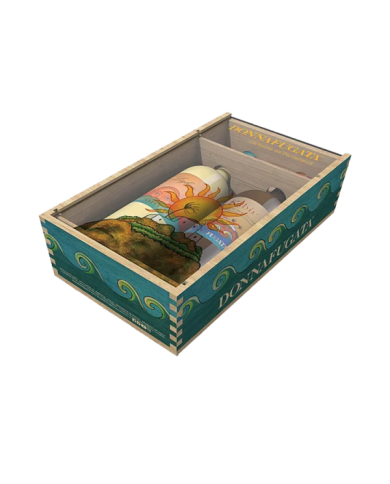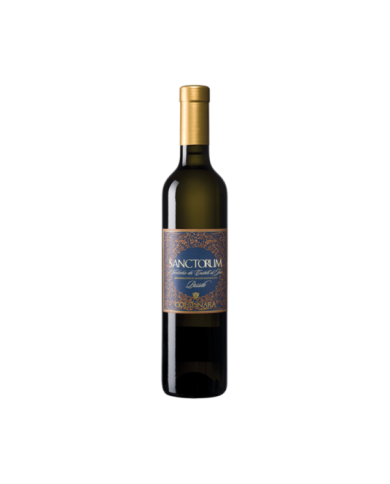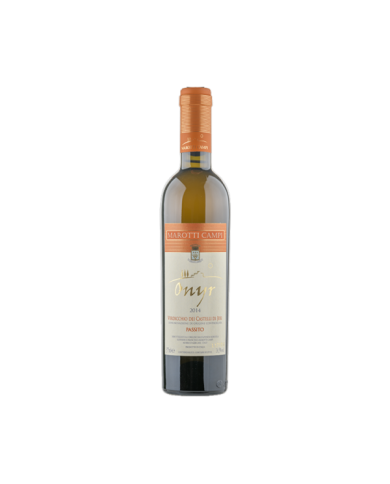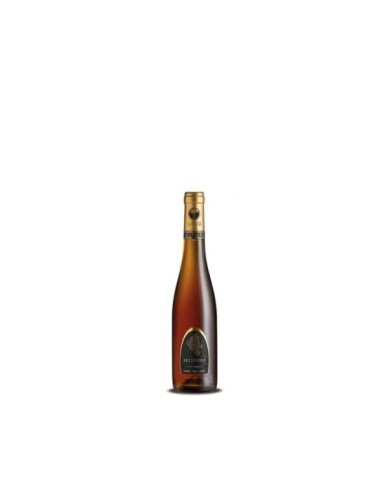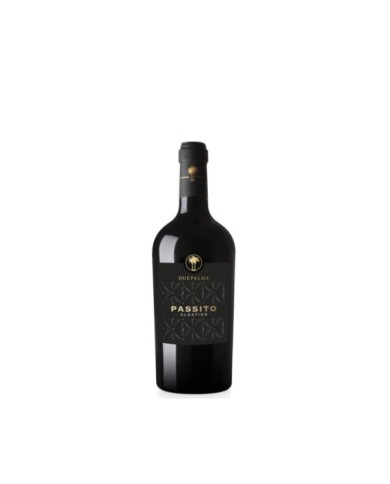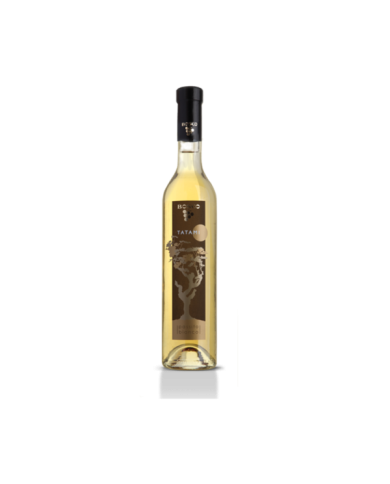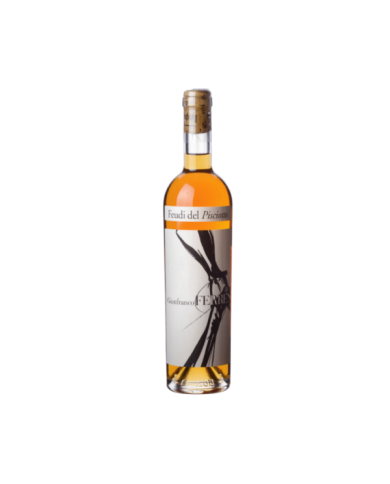In the mouth it leaves a great complexity with successive sensations of fruit and rich jam. The final sensations are of great balance between the sweet note and acidity, with a savory component.
Obtained thanks to the drying process of Sagrantino grapes.
Very ample wine, with great structure with a long aromatic persistence and a typical tannic finish supported by a pleasant sweetness.
Wine with great evolutionary capacities in the bottle. In fact, it can be refined in the bottle for many years, significantly improving.
Intense ruby red and full to the eye. The nose firstly gives deep notes of dark fruit, such as blackberries, sour cherries and black cherries, overripe and jam, then followed by references to eucalyptus, tamarind, cinnamon, myrtle and cocoa. The palate is all played between sweetness and tannins, to prove balanced, full-bodied and with a long persistence. Perfect with chocolate and excellent with fruit tarts, it is also ideal sipped alone as a meditation wine.
A dessert wine from the Pescaresi Hills, Abruzzo, Italy. Made from Moscato Bianco grapes.
Excellent in combination with pastry desserts, fruit tarts, homemade focaccias and even desserts with creams.
The combination we suggest is a goose foie gras escalope, but perfection is achieved in a glass, in front of the fireplace in good company!
Excellent pairing with small dry pastries or typical sweets such as "fregolota".
The combination we suggest is a goose foie gras escalope, but perfection is achieved in a glass, in front of the fireplace in good company!
Excellent pairing with small dry pastries or typical sweets such as "fregolota".
Excellent with dry desserts, but also with soft cakes made with bitter chocolate or with berries. Try it with particularly tasty mature or blue cheeses.
Excellent in combination with pastry desserts, fruit tarts, homemade focaccias and even desserts with creams.
This sweet wine has a unique style. The red color is impenetrable, the scent evokes blackberries, dried fruit and cinnamon, the taste is of a singular balance. In fact, the dense texture of tannins imprisons acidity and sweetness and everything is confused, creating a gustatory sensation of harmonious fullness. It is thanks to the drying of Sagrantino grapes on racks that such a concentration is obtained. Originally Sagrantino grapes were used only for the making of this sweet wine, drunk on the occasion of religious ceremonies in the villages of the area.
From this ancient vine dear to the Popes, which was cultivated in Italy as early as 200 BC with the name of Apicia, Apicius or Apianae - according to Colummella and the other Georgics, a sweet wine with a Moscato flavor was obtained.
Unmistakable harmony between structure, sweetness and freshness.
- \ n
- Type White Wine \ n
- Vintage 2012 \ n
- Capacity 0.375 l \ n
- Country Italy \ n
- Gradation 15 ┬░ \ n
- Tuscany Region \ n
- DOCG classification \ n
- Grape variety Malvasia, Trebbiano \ n
Bartolo Mascarello , Dolcetto d'Alba 2020 is an explosive wine with marked notes of red fruits, earth, wild herbs. Robust and rustic wine without giving up the finesse, a milestone characteristic of the Mascarello Bartolo winery. Bartolo Mascarello Dolcetto d 'Alba is a deep and intensely aromatic red, with a deep ruby color. The nose offers a greedy and persistent bouquet with refined aromas of violet and lavender mixed with black cherry and sweet spices. On the palate it offers a wide range of flavors, with a prevalence of fruit and then strokes of rosemary and thyme. Its delicate acidity is refreshing and perfectly integrated.
Deep and intense golden yellow color. The nose expresses an intense, ample, slightly aromatic aroma, with a hint of honey. In the mouth it is soft, sweet, warm, round, it recalls the olfactory sensations. Excellent at the end of a meal accompanied by typical Sicilian sweets, such as cannoli, Sicilian cassata and almond sweets.
Cru di Recioto that stands out for its particular complexity and its characteristic almond aftertaste. Its subtle delight is the gift of well-ventilated vineyards that allow perfect drying. It is considered a real rarity. At the first impact in the mouth it is sweet and full. Then he performs a seductive miracle, giving a more authoritative, dry and complete feeling. Finally, it leaves the memory of a bitter sweet experience, which recalls dark chocolate and fine cigar.
Very concentrated with high residual sugars but well balanced by acidity, a wine with a very long aging to be served at a temperature of 7-8 ┬░ c.
After drying, the grapes are pressed and the must obtained, after a first racking, is left to ferment with the use of special selected yeasts . The must ferments at a low temperature, about 15 ┬░, until it has developed about 12 degrees of alcohol. Subsequently, the cleaned and filtered wine is placed in barriques for refinement, during which there is a slight fermentation recovery. Refinement lasts approximately 18 months . After this period the wine was filtered and bottled to be further refined in the bottle for about 6 months .
Amabile del Cere is a white passito from Veneto made from various white grapes. It is a blend based on chardonnay, garganega, Tuscan trebbiano and sauvignon. The grapes are harvested at the end of September, followed by drying in wooden boxes and pressing in January, when the botritys worked at full capacity on the volume and sugar residue of the bunches. Quintarelli 's passito is then aged for 5 or 6 years in French oak. Exquisite, sublime, delicate. The fifth essence of sweetness. The amber color, the notes of bergamot, candied fruit and spices accompany a vertical, delicate and engaging sip. A passito from the past, with an enormous potential for spectacular evolution. A meditation wine to be savored on rare occasions, excellent with dry or sliced desserts.
It is our homage to the pleasures of life, to be grasped with lightness and simplicity. The aroma of a sweet pleasure.
The care and effort of an extreme production work are illuminated by golden flashes that bring with them an intriguing bouquet, full of sweetness and freshness.
amber yellow wine, delicate bouquet, full and harmonious taste with hints of honey and tropical fruit.
AROMATIC AND LAMINATED GRAPES
Angialis Isola dei Nuraghi Igt by Argiolas is a wine with an intense straw yellow color. On the nose they result in very intense primary aromas, markedly Mediterranean. Terpenic characters typical of Nasco.
Excellent to conclude festive lunches and dinners, it is perfect if combined with the Neapolitan pastiera.
Traditional Vin Santo both in the blend, Trebbiano and Malvasia, and in the processing method. The grapes, harvested in early October, are dried on racks until December, and then softly squeezed. The must obtained ferments slowly and refines for 5 years in small oak barrels (kegs).
Traditional Vin Santo both in the blend, Trebbiano and Malvasia, and in the processing method. The grapes, harvested in early October, are dried on racks until December, and then softly squeezed. The must obtained ferments slowly and refines for 5 years in small oak barrels (kegs).
With an intense ruby red color, it is a velvety wine, which contains hints of cherry, raspberry and dried fig. On the palate it reveals slight notes of violet that pamper and caress the end of the meal. Maximum Expression: 8-10 years. Vinification: On the skins for 18 days, followed by static decanting in large barrels. The wine is aged for 9 months in barriques and then rests for 6 months in the bottle.
Cooked must is a typical Abruzzo product obtained by cooking red berried grapes, excellent for garnishing desserts and ice creams, but also for dressing salads and preparing slushes. 375 ml bottle
Excellent with desserts at the end of a meal, it finds its most original combination with great aged or blue cheeses. Full and enveloping body, with an intense sugary sensation but well balanced by the natural final acidity, rich in fruity aftertaste nuances. The grapes are harvested overripe, put in large perforated crates (binz) and stored in a cold room for 45 days until the natural drying process is completed. When harvested, the best bunches are sorted and brought to the cellar, pressed and softly pressed.
A passito with a long tradition, but with a style made modern through the mass selection of the most aromatic and acidic Moscatelli and a winemaking process that aims to enhance the fresh primary aromas.
Amber yellow to the eye, with an intense and aromatic nose. On the nose it opens with hints of honey and caramel, candied citrus fruits, dried fruit and cloves, which lead to a warm and satisfying sip, with a full and decisive taste. Closes on beautiful mineral and orange blossom sensations.
Excellent to accompany cream desserts, dry pastries and pies. Try it with blue or aged cheeses paired with honey.
Pinotto is the sweet red of the Carboni winery: an IGT Isola dei Nuraghi Rosso Passito , obtained from an atypical vine for Sardinia, typical of central Italy with an aromatic character , which some winegrowers have started a few years to plant in certain areas of the Mandrolisai. It is a wine produced in very small quantities , only in the years deemed most suitable.
From one of the oldest vines in the world, Moscato Bianco, our Passito di Noto is born. Passito is an ancient wine that becomes current with a modern drying system. Explosive aromas of exotic fruit, jasmine, candied citrus, it is both complex and easy to love. The ideal companion of the great Sicilian tradition of sweets and ice cream.
Obtained from the Montepulciano grape, left to dry for months after the harvest, then vinified with a natural process. A sweet wine to never forget.
Passito bianco di Tollo is produced with Moscatello grapes (Moscato Bianco) from 15-20 year old vines grown on the Pescara hills. The nose has aromas of flowers, jam, ripe fruit with white pulp. In the mouth it is intense, rich in aromas and hints of ripe fruit and raisins. An excellent end of a meal.
Packaging in wooden box containing 1 "Vin Santo di Montepulciano 2005" + 1 "Vin Santo di Montepulciano" Occhio di Pernice "2005" in 375 ml bottle. A quality sweet wine that reveals new, surprising flavors with every sip: figs, almonds, lemon and coffee beans, while a perfect balance between acidity and sweetness complements the sensual aftertaste.
Avignonesi 's Vin Santo Occhio di Pernice is an extraordinarily rich sweet wine, produced from Sangiovese grapes and aged for 10 years in kegs. It exudes aromas of dates, dried fruit, panforte and sweet spices. On the palate it is sweet and sensual, infinite, with notes of cedar, salty candies and freshly baked biscuits
Avignonesi 's Vin Santo Occhio di Pernice is an extraordinarily rich sweet wine, produced from Sangiovese grapes and aged for 10 years in kegs. It exudes aromas of dates, dried fruit, panforte and sweet spices. On the palate it is sweet and sensual, infinite, with notes of cedar, salty candies and freshly baked biscuits
Avignonesi 's Vin Santo di Montepulciano is a sweet wine of great elegance obtained from Malvasia and Trebbiano and aged for 10 years in casks. The nose releases intense aromas of caramel, chocolate, honey, orange peel and Mediterranean herbs. The taste is rich and enveloping with notes of figs, almonds, lemon and coffee
Avignonesi 's Vin Santo di Montepulciano is a sweet wine of great elegance obtained from Malvasia and Trebbiano and aged for 10 years in casks. The nose releases intense aromas of caramel, chocolate, honey, orange peel and Mediterranean herbs. The taste is rich and enveloping with notes of figs, almonds, lemon and coffee
Ornus dell ' Ornellaia , the result of a late harvest of Petit Manseng, is a wine produced in extremely limited quantities, capable of giving a new dimension to the estate. In some vintages the very small ŌĆ£PalmettaŌĆØ vineyard offers the perfect conditions for the production of this exclusive sweet wine. The name Ornus dell ' Ornellaia is inspired by the' Fraxinus Ornus', the Latin name of the Ornella, the tree to which we owe the name of Ornellaia . Typical plant of the Mediterranean scrub, also known as the 'manna tree' due to its precious biblical lymph used as an ancient sweetener, the Orniello or 'Faxinuns Ornus' alludes with perfect correspondence to the sweetness of Ornus dell' Ornellaia .
The Muffato del Castello della Sala, one of the estates of the Marchesi Antinori , is a bright and persuasive sweet wine. On the nose it is a wine that reveals itself of great aromatic and gustatory intensity, with hints of candied fruit, honey, iodized and almost marine hints on a citrus hint. On the palate it is enveloping and the botrytizing process gives a sweet sensation well integrated into that of freshness that emerges after the sip
In Pantelleria, a volcanic island located between Sicily and Africa, Stefano and Simona boasts 2 hectares of vineyards and produce only 2000 bottles a year. The vine is the zibibbo, prince among the aromatic varieties, the vines are grown on a very low bush, modeled by the wind, on small terraces bordered by dry lava stone walls.
In Pantelleria, a volcanic island located between Sicily and Africa, Stefano and Simona boasts 2 hectares of vineyards and produce only 2000 bottles a year. The vine is the zibibbo, prince among the aromatic varieties, the vines are grown on a very low bush, modeled by the wind, on small terraces bordered by dry lava stone walls.
Golden yellow, with bright amber reflections. The nose is characterized by a wide range of honey aromas, withered white flowers and dried fruit. On the palate, the sweet notes and the references of candied orange and apricot jam find the right counterpoint in a pleasant acidity that cleans the palate and supports the long persistence.
Dedicated to Donna Plautilla A. ancestor of our family who lived in the second half of the eighteenth century (1759-1809) and dedicated to all the women of Montefalco, the true guardians of the Sagrantino Passito tradition. The women were entrusted with the task of detaching the Sagrantino grapes from the stalks, the ŌĆ£sbacaturaŌĆØ for the subsequent vinification and it was a job that was done by the fire after dinner, in the cold evenings of late autumn. Images of true poetry for a wine that is itself poetry. The harvest of Sagrantino destined for drying takes place in the first days of October and is very meticulous. The clusters are treated with extreme care because they absolutely must not break, they are placed in small boxes whose bottom is covered with a layer of vine leaves (vine leaves). Only suitable bunches are harvested, those with the most sparse berries that can better withstand the long drying period on the ŌĆ£CamorcanneŌĆØ, racks where the bunches are placed side by side, without overlapping. The drying can last even more than two months, depending on the weather conditions. Once the right sugar content is reached, the vinification is the same as for other wines: temperature control, frequent pumping over, racking, soft pressing and racking. The final wine yield is very low, only 35% of the initial quantity of grapes. Unlike the Rosso and the dry Sagrantino it does not age in wood, but in steel barrels for a period of thirty-six months. Then follows the refinement in the bottle. The bottles produced are all numbered by hand.
Obtained thanks to the drying process of Sagrantino grapes.
Very ample wine, with a great structure with a long aromatic persistence and a typical tannic finish supported by a pleasant sweetness.
Wine with great evolutionary capacities in the bottle. In fact, it can be refined in the bottle for many years, significantly improving.
Forteto della Luja Loazzolo is a fragrant and enveloping wine, with a deep yellow color with apricot and gold reflections. The olfactory profile reveals a rich, ripe fruit, with a prevalence of apricot notes. The "muscat" root of the fruit is evident, which a balsamic wood enriches with spicy and roasted notes. Rich and creamy on the palate, to which it unfolds in all its multifaceted sweetness and alcohol, with interesting returns of fruit, chocolate and honey. A very pleasant wine, which ends long, with an echo of vanilla and white chocolate. Constitutionally long-lived, it maintains an enviable gustatory balance for many years. Excellent meditation wine, it goes well with aged cheeses and desserts.
This sweet wine has a unique style. The red color is impenetrable, the scent evokes blackberries, dried fruit and cinnamon, the taste is of a singular balance. In fact, the dense texture of tannins imprisons acidity and sweetness and everything is confused, creating a gustatory sensation of harmonious fullness. It is thanks to the drying of Sagrantino grapes on racks that such a concentration is obtained. Originally Sagrantino grapes were used only for the making of this sweet wine, drunk on the occasion of religious ceremonies in the villages of the area.
Intense ruby red and full to the eye. The nose firstly gives deep notes of dark fruit, such as blackberries, sour cherries and black cherries, overripe and jam, then followed by references to eucalyptus, tamarind, cinnamon, myrtle and cocoa. The palate is all played between sweetness and tannins, to prove balanced, full-bodied and with a long persistence. Perfect with chocolate and excellent with fruit tarts, it is also ideal sipped alone as a meditation wine.
The Donnafugata Sweet Pochette is an innovative packaging that reproduces a cardboard handbag, perfect for storing and carrying two bottles. The refined accessory contains a prestigious Ben Ry├® Passito and Kabir Moscato di Pantelleria Doc. A gift idea with a look at the female world.
Bright amber yellow, the nose expresses a wonderful olfactory profile composed of notes of apricot and peach, dried figs and honey, aromatic herbs and mineral notes. Intense and bewitching aromas, solar and Mediterranean, which open to an immense taste for complexity, perfect in the fusion of sweetness, flavor and softness. Very long, interminable, poignant. Strictly at the end of a meal, ŌĆ£Ben Ry├®ŌĆØ is a perfect accompaniment to blue or very aged cheeses and foie gras. Also excellent on ricotta desserts and dry pastries.
A passito that contains the essence of Verdicchio, what is most holy in the saint: for this reason the derivation of the name from the expression Santa Sanctorum. The Passito Wine is the result of the processing of dried grapes in the vineyard, which retain only the pure soul of the Verdicchio grape, and which then ferment slowly in small oak barrels.
Golden yellow tending towards amber. On the nose yellow flowers, candied fruit, peaches in syrup and pine nuts. Soft on the palate, tending to sweet, allowing apricots and baked pears, notes of vanilla and a slightly almond finish. Serve at 14 ┬░ with dry sweets, almond paste, cheeses or cheesecakes, foi gras or alone as a meditation wine. Alcohol: 14.5% vol.
Intense golden yellow with amber reflections. The nose reveals elegant aromas of ripe fruit, candied orange and a note of acacia honey. In the mouth it is sweet, enveloping, pleasantly characterized by balsamic traces of spices before a finish of great persistence. At the end of the meal, it is enhanced with small cream-based pastries but also with pies and biscuits.
Orange red color. The nose is expressed with hints of jam, notes of honey and hints of toasting. On the palate it is warm, full-bodied, soft and pleasantly refined. Ideal for cheering after dinner, it goes well with red fruit tarts.
Color : intense golden yellow. Nose : floral aromas and notes of dried fruit. Taste: sweet, warm and enveloping. Serving temperature: 10 ┬░ C. Pairings: medium-aged cheeses, desserts. AWARDS: 4 Grappoli, Bibenda 2014 - Best debut, Gold guide Veronelli wines 2014
One of the best Italian sweet wines Label designed by Gianfranco Ferr├©. Aromatic notes and perfect acidity stand out. A product characterized by balanced flavors, with perfect sweetness and offering clear hints of dried fruit, honey and rose.
Discover the Delight of Sweet Wines: A Journey for Your Senses
Sweet wines can be a real treat for your senses. The way sweet wine touches your taste buds and nostrils with its rich fragrances will make you feel in heaven. The magic of sweet wines is unique and is becoming increasingly popular among consumers seeking a unique sensory experience. If you are looking to discover the beauty of sweet wines, then you are in the right place. This article will explore some of the best sweet wines and how to choose the right one for you.
What is a Sweet Wine?
First of all, we need to clarify what a sweet wine is. A sweet wine is a wine that contains a certain amount of sugar. This sugar can be added during fermentation or it can be added afterwards. The amount of sugar in sweet wine can vary from slightly sweet to very sweet. Sweet wines are often sweeter than dry wines because they contain more sugar.
Most Popular Sweet Wines
Sweet wines can be divided into three broad categories: dessert wines, sparkling wines and aromatised wines. Dessert wines are those that are sweeter and more aromatic, such as Port, Sherry, Muscat and Madeira. Sparkling wines are carbonated wines such as Champagne, sparkling Muscat, Prosecco and Cava. Aromatised wines are those with a fruity flavour, such as Riesling, Gew├╝rztraminer and Gr├╝ner Veltliner.
How to Choose a Sweet Wine
If you are interested in trying a sweet wine, there are a few things to consider. First, you need to decide whether you want a dessert wine, a sparkling wine or a flavoured wine. You will also have to consider your budget and personal taste. If you are a beginner, you might want to start with a less expensive and less sweet wine, such as a Muscat or Riesling. If you are an expert, then you may want to explore rarer and more expensive wines such as a Port or Sherry.
How to Serve a Sweet Wine
If you have decided to try a sweet wine, it is important to serve it in the right way. Dessert wines should be served chilled, while sparkling and flavoured wines should be served at room temperature. The right temperature for a sweet wine varies depending on the type of wine, so be sure to read the labels before serving. Dessert wines should be served in larger dessert glasses, while sparkling and aromatised wines should be served in wine glasses.
How to Pair a Sweet Wine
One of the advantages of sweet wines is that they can be paired with many different dishes. Dessert wines can be paired with desserts, cheeses and meats. Sparkling wines can be paired with all kinds of dishes, from savoury to sweet. Aromatised wines are particularly versatile and can be paired with fish, meat and vegetable dishes.
Conclusion
Sweet wines are a fun and relaxing way to enjoy a meal or an evening. Whether you are a beginner or an expert, there is a sweet wine to suit your needs. Remember to choose the right wine for your meal, serve it at the right temperature and pair it correctly. If you follow these steps, you will definitely enjoy the deliciousness of sweet wines.


